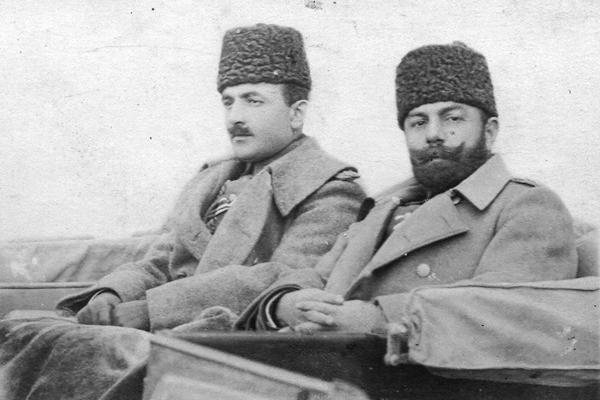
How to prove that the authorities of the Ottoman Empire had the intention to destroy, in whole or part, the Armenian population?
The intentional element is fundamental to criminal law. It is the psychological state of the offender. Under intentional crimes, the perpetrator must commit the offense and with the desire to achieve a result prohibited by law. The intentional element is present in the crime of genocide. It is even decisive encounter this type of offense. According to the authors, "it is the intention that determines the specificity of genocide." In addition to the general intent to commit a criminal act prohibited, genocide requires a specific intent that is called a special intent: intent to destroy, in whole or in part, a national, ethnical, racial or religious group, as such.
The criterion of intention has been strongly criticized by some authors who see it as an obstacle to the pursuit of genocide. Indeed, the proof of that intent is difficult to report. The officers of genocide can hide behind the lack of proven intent to destroy a group as such to challenge the charges against them. As written by Cassese, the element of intent "provides a convenient loophole for States: they deny having committed genocide, say precisely the element of intent missing." In the same vein, the criterion of specific criminal intent does not always fully meet the specific characteristics of a genocide that is the result of a dynamic, complex and often random process. Proof of intent is difficult since sometimes the intent to destroy a group of people is built progressively and not always the result of a sudden, clear and irrevocable decision.
Turkey still denies today that it had, in 1915-1916 through official government then in place, the intent to destroy the Armenian community in the Ottoman Empire. There is therefore a denial on the part of Turkey on the existence of a special intention; intention absolutely necessary for the crime of genocide to be established under international law. The need to provide proof of a specific criminal intent is an inherent weakness of the international criminalization of genocide in that it opens the door to denial.
There is little written to prove deliberately the extermination of the Armenian people. Official papers and telegrams have largely been deliberately destroyed after the signing of the armistice in 1918 by members of the Ittihad party.
The famous "Andonian Documents" can be used to prove the existence of criminal intent. They were recovered after the First World War by an Armenian journalist named Aram Andonian. There were letters and telegrams exchanged between the administration of deportations and Talaat, Minister of the Interior. As it stands, these documents are a clear proof of the Ottoman state to eradicate the Armenian presence at the Empire.
One of the best known and most eloquent was a telegram sent by Talaat to the Aleppo’s Prefecture on September 9, 1915 when he wrote: "The right of Armenians to live and work in the territory of Turkey is totally abolished and the government, assuming all responsibilities in this regard, ordered to not even let the children in the cradle.”
Other elements indeed show the existence of a deliberate intention to exterminate the Armenian population.
The minutes of a secret meeting of the Central Committee of the Ittihad party kept in the British archives is a particularly convincing document. The meeting was certainly held in January 1915 after the defeat of the Ottoman army against the Russian army in Sarikamich. It was at this time that some members of the Ittihad (Talaat, Nazim, including Chakir) established the "ten commandments" for the Armenian resident population of the Empire.
These commandments served as circular to validate (the equivalent of regional governors) so they start running the extermination of the Armenian population. This document can be considered authentic. It was recovered by the British authorities in 1919 through Ahmed Essad former head of Turkish intelligence service who was secretary of the secret conference Ittihad in January 1915. This document alone could serve as irrefutable evidence of real and planned intent to exterminate the Armenians of the Ottoman Empire. We could add many foreign stories, the stories of survivors, Ottoman documents as a result of martial trial courts which all show the existence of a deliberate attempt to exterminate the Armenian people.
To strengthen the evidence of the intent to destroy the Armenian population as such, it is useful to appeal to corroborating elements. Positive law, evidence of intent to commit genocide, can be reported on the basis of objective factors:
First, the number of victims is a strong indication of the intent to destroy a group of people.
In the case of the extermination of the Armenians, the number of victims, although still disputed by some Turks historians oscillates between 1.2 million and 1.3 million, or two-thirds of the Armenian population. Such huge number of victims – as they are associated with a wide geographic area and a repetition in time – naturally invite to infer an intention to destroy all Armenians in the Ottoman Empire.
Second, an objective element revealing the intention may be derived from the organization of massacres. There is no doubt that the physical destruction of the Armenian people was organized at the highest peak of the state through a pyramidal structure: the orders were transmitted from the Ministry of the Interior to the Wali who then run them on the ground.
The deportation of Armenians was, in turn, entrusted to a Commission of the deportees. So there was an administration whose function was to manage the process of extermination of the Armenians. Massacres and deportations were not designed and implemented in isolation but instead met a real plan. There was a clear goal: extermination, destruction, annihilation (these words are found in various testimonials) of the Armenian people.
In addition, the Unionists indictment trial pointed the intentional extermination of the Armenians. In his words, the destruction of the Armenians was "the result of decisions taken by the Central Committee of the Ittihad." According to the act of prosecution, there was a decision for the extermination plan whose implementation was done through orders submitted either orally or in coded messages. The text of the indictment even stated that "the murders were committed in the order and with the knowledge of Talaat, Enver and Djemal Bey."
One last point about the mental element of genocide should be made. Article II of the 1948 Convention provides that the intent is that to destroy a group "in whole or in part". This nuance of the intent to destroy either all or only a portion of a human group has been extensive. This means that the intent to destroy a group can cover only a part of this group. It is then that part of the group of people whose extermination is required is substantial. For there to be genocide, it is not necessary that the offenders have the intention of the victim group disappearing off the face of the planet. The continued partial removal (which can naturally cause millions of deaths) is enough to characterize the crime of genocide.
In the Armenian case, the Ottoman authorities had the intention to exterminate the Armenians of the Ottoman Empire and not all Armenians of the world (which specifically concerned the existing Armenian diaspora in 1915). The extermination of the Armenians had no universal vocation. The pattern was essentially political: it was set by the mass murder to resolve the "Armenian Question", in the context of an Ottoman Empire threatened with disintegration. The fact that the intention was that of a removal of part of existing Armenians did not prevent the qualification of genocide.
Rodney Dakessian
30-juillet-2013

